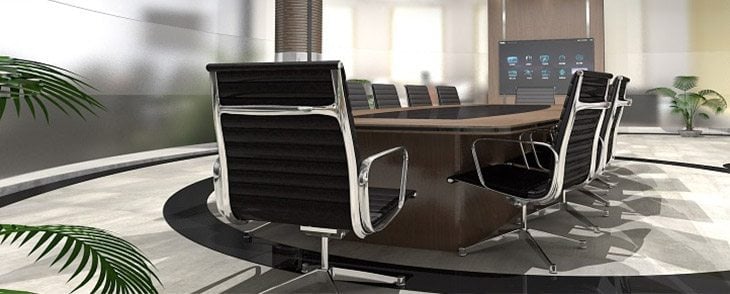It is not uncommon for a new home-based business owner to locate their office in the one of the smallest rooms in the house, as balancing the space needs of the business and the family is a challenge.
This makes it even more critical that the office space be well used and highly utilitarian in its design and layout.
The days of placing a spare kitchen table and a couple of cardboard boxes are gone in home office layout.
Today, sophisticated electronics, substantial file storage and abundant work surfaces are required to productively run a home business.
This post is writing in a Q&A format using questions submitted by members of our community.
Question 1: In order to maximize money available to create my new products, I want to create a home office in my studio apartment to eliminate outside rent. Any suggestions on how to best use my limited space?
Answer: The key to good use of limited space is to use both vertical and horizontal space as productively as possible. Several steps will aid you in producing and effective design.
First, plan ahead. Make a diagram of your space and list everything you feel you will need to put into the space, such as a desk, chair, lamp, computer table, bookshelves, fax machine, wall decorations, presentation equipment and supplies, file cabinets, etc.
Many office supply stores stock templates that provide a grid to depict your office space and symbols to scale to represent common equipment. Have some fun moving the pieces around the grid.
Second, think small. Look at storage units that can be added onto easily and modular desks that open into a number of sections.
Many manufacturers of RTA (ready-to-assemble) furniture, such as O’Sullivan and Gusdorf offer this type of computer desk.
Third, figure out the best way to store items efficiently. Do this by making lists of items you use daily, weekly and occasionally. Store them accordingly.
Fourth, use color to cheer up the space. Consider coordinating the drapes or blinds and an area rug. Create a focal point with eye-catching art on the walls. Lastly, build up, not out. Within limits of safety and visual harmony, don’t be afraid to build shelves over your desk or over a sofa.
Question 2: A friend of mine’s house recently caught on fire and destroyed most of her home office. She is out of business now. How can I avoid this tragedy?
Answer: Of first importance, of course, is to try to avoid a fire in the first place by being extra diligent in using fireplaces, space heaters and other high-power appliances.
To protect against total disaster in the event of a fire or other catastrophic occurrence, follow theses tips:
Insure your business property. Don’t assume that your homeowners or renters insurance covers your computer and office furniture. Call your insurance agent and specifically ask.
-
- Document your possessions with photos or video and include detailed descriptions of each major piece of equipment or furniture, including serial numbers where applicable.
- Regularly back-up important computer data. Keep the disks outside of your office, such as in a safe deposit box.
- Use U.L. approved extension cords and surge protectors on your equipment. Don’t string too many pieces of equipment on one outlet.
- Ensure that all doors and windows lock securely. If your office faces onto the back yard, consider installing a motion-sensor light outside of your office window.
- Draw your blinds or drapes at night and when you are out of the office for some time. Don’t make it too obvious what you own.
- Keep your office straightened up. Reduce paper clutter!
- Make sure you have an approved fire extinguisher at hand and install a Check your roof each year to assure that no leaks are developing. One day of leaking into your office can destroy months worth of work.
- If you stock inventory in your home office, buy an insurance rider to specifically cover the full replacement value of the inventor






